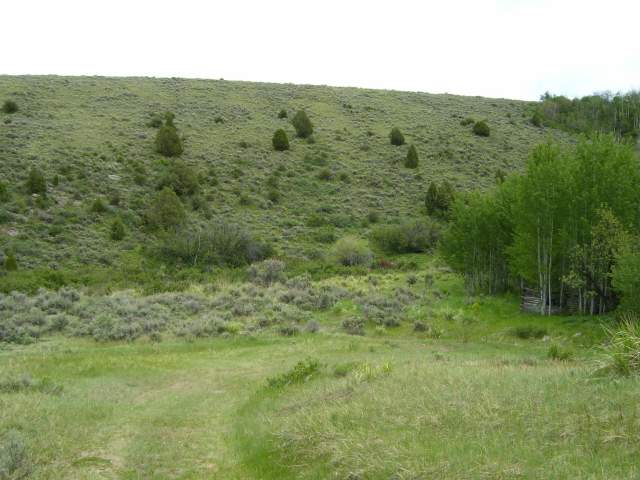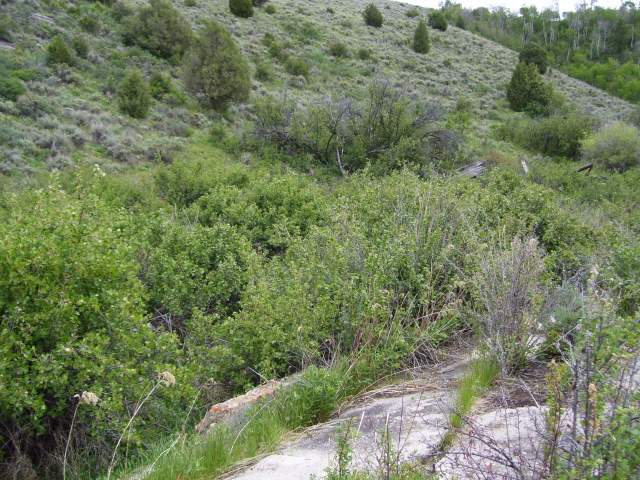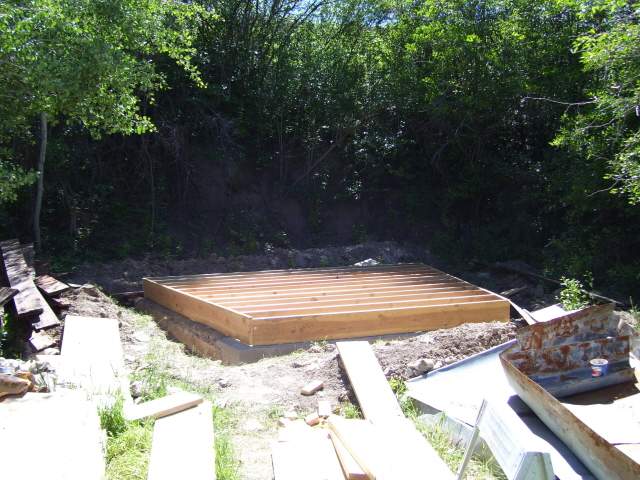Our History
The following Green Canyon Hot Springs history was written by Phil Neibaur, Joint Owner and manager of Green Canyon Hot Springs, for the centenial celebration in 2003.
PREFACE
It is with a great deal of thanks that I write this history of Green Canyon Hot Springs. I thank the many people who have shared stories and pictures, Thayne Nelson in particular. I thank the Pincock family and Mrs. Verla Pincock Moss, my sixth grade teacher, especially for the wonderful history of the Pincock family which is so delicately laced with the history of Green Canyon. I thank Lewis Clements and Harold Forbush for their research and accounting of Green Canyon as presented in “The History of the Upper Snake River Valley.” I thank Grover Browning and Wayne Stevens for their rich memories. I thank my parents and grandparents who ran the business before my brother Randy and I. Most of all I thank the “friends” of Green Canyon who have given us a vote of appreciation with every camping and swimming ticket they have bought. It is because of you, and for you that we are still here after 100 very short and enjoyable years.
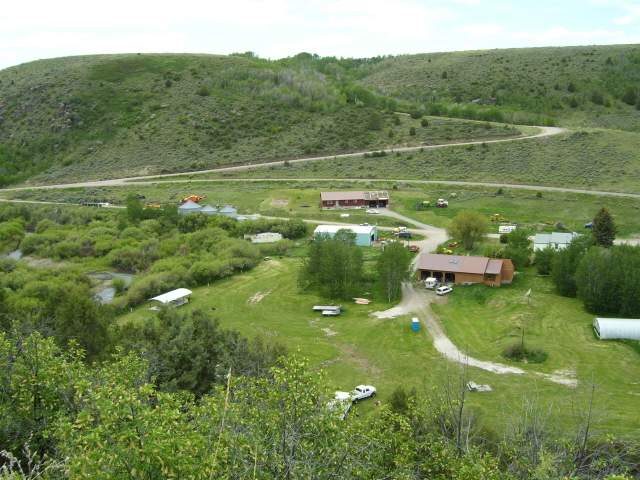
INDIANS AND EARLY WHITE MEN
INDIANS AND EARLY WHITE MEN
Up until the first white men came into the area, little is known about the hot spring and the human activity concerning it. But it isn’t hard to imagine the Indians, who seasonally made there home in this area, enjoying a cleansing and relaxing morning or evening soak in the sparkling clear hot spring water.
The springs issue forth from the base of the Big Hold mountains at a temperature of 115 degrees Fahrenheit, a little east of the present building. The water contains magnesium, lime, and trace of iron, but no sulfur. Sulfur is very common in other hot springs and gives them a distinct smell.
The hot springs were first visited by white man in 1811. Wilson Price Hunt visited them while spending time at Fort Henry. The rest of his crew built canoes for their ill-fated trip down the Snake River. Mr. Hunt was to establish a trading post at the mouth of the Columbia River. Planning to meet a supply ship sent around South America and bound for the Pacific Coast, Hut, upon arrival, found his ship was blown up and sunk due to an Indian raid. To send the news back to the mother company in St. Louis, he sent seven men to go overland. The group, led by Robert Stuart, made its way eastward, following the Snake River, and ran into Indian trouble near the head of the present day Palisades Reservoir. Horses stolen and left on foot, they built rafts and floated down the river to what we no know is Ririe, Idaho. At this point, they decided to go cross-country to the Teton Mountains. In late September of 1812, they stopped and camped here, and soaked in the hot springs before crossing the Big Hole Mountains into Teton Valley on October, 1812. One of the groups rebelled, refusing to cross “another mountain,” and walked around the smaller hills to the North, a longer but easier route. The individual did make it, and they joined up again in Teton Valley. The group eventually made its way to St. Louis after suffering from serious hunger.
Robert Stuart’s Party made a considerable contribution to the westward movement by traveling the entire length of the Oregon Trail except for their detour through Eastern Idaho.
THE CREATION OF GREEN CANYON AS A BUSINESS
It came as little surprise to me that the town of Sugar City also celebrated their centennial in 2003. Not only does Green Canyon and Sugar City share the same birth year but history would surely place them as cousins in the same family of Pioneers.
Sugar City was one of the last of the area towns to be created and settled. On August 5, 1903 the Fremont County Sugar Company was organized in Salt Lake City by Joseph F. Smith, John R. Winder, T.R. Butler, W.S. McCornick, John Henry Smith, Mark Austin, John C. Cutler, Richard W. Young, and Horace G. Whitney. In October of that same year E. H. Dyer and company was given a contract by the newly formed Fremont County Sugar Company, to build a factory at a location near Salem, five miles northeast of Rexburg. The town that would develop as a result of the business venture was to be named Sugar City. The cornerstone for the new factory was laid at a special ceremony held December 8, 1903.
Green Canyon began that same year as a side venture to the new sugar factory. In order to build the factory, the contractor needed lime for the mortar used in laying the brick. Lime was also needed for the sugar making process after the factory was up and running. Two brothers John E. and James H. Pincock took a contract to supply the lime for the new plant, and the closest lime deposit for them was here at the hot spring. The big white rock just east of the pool is made up of lime. The Pincock brothers filed on a limestone claim and began to mine, burn, and powder the rock for the contract made to E.H. Dyer.
Part of the original land accusation for the Pincocks was a homestead claim. It included 100 acres of farm land. But the spring was owned by a man named Butler, often called “fish” Butler by his friends and neighbors. The Pincocks purchased the springs from him and filed for the water right at Fremont County in 1898 (before the lime contract in 1903). [Note: We were once part o Fremont County and later Madison County was created and we became part of it.]
The rest of the Pincock story is told by Mrs. Verla Pincock Moss, my sixth grade teacher:
In February 1851 John Pincock married Isabella Douglas in St. Louis where a daughter was born. They came to Utah and John E. was born in Kaysville. The family moved to Ogden where twelve more children completed their family. James H. was five years younger than John E.
James H. Pincock made his first trip to the Snake River Valley in 1879. He made two more trips to the valley before marrying Ann Elizabeth Garner. The urge to return to the Snake River Valley to help colonize it became stronger and stronger for James. By spring of 1883 James H., his brother, John E., and a brother-in-law, John A. Garner, and Harold Heninger started north. They reached the spot where Rexburg now stands on May 7, 1883, then went on to make claims one mile east of where the old Sugar Factory stood. By the spring of 1884 the two Pincock brother and Garner had constructed log homes sent for their wives and families, and established themselves in the valley.
John E. and James H. claimed a piece of land on Canyon Creek, about 20 miles east of their homes in the valley. The prime purpose of the claim was to mine, process, and sell lime found on this land for construction of the sugar factory. The Mineral Patent was recorded in the General Land Office at Blackfoot, Idaho, in 1909 and was known as the Warm Spring Ledge Placer Mining Claim, granting the Pincocks’ the right “to have and to hold said mining premises.” Slack lime or limestone that had been burned and powdered was used to make the mortar to hold the bricks together. Later lime was used in the sugar-making process. The Pincocks built a kiln (which still stands today), quarried the rock, burned the lime, and hauled it with two wagons hooked together, pulled by four head of horses or a string of oxen. Frank and Whitney Pincock and Charley Nibley did a lot of this work. Roads over the hills and through the hollows were not very good and great care and know-how was needed to make a successful trip without breakdown and mishap.
A hot spring was discovered near the claim and it was found that an old man by the name of Butler owned the spring. James H. and John E. purchased the spring from him. A notice of Water Right was signed by them and filed with the court on May 24, 1898. This deed gave them the right to sue the water for agricultural, medicinal, bathing, power, milling, stock growing, and domestic purposes. There were about five cubic feet of water per second at the mouth of the spring. The 20th of July 1910 James H. and Annie E. Pincock signed the Warranty Deed that gave John E. the sole ownership of the mineral rights and the water for one dollar ($1). James did not have any desire to be involved in the development of a “bathing pool.”
Soon, John E. and his boys dug out a small pool which was just a hold in the side of the hill. They built steps down into the water. Most family members did not like the get off the steps. Even though the water was very warm, moss was thick. No one could stay in very long. Whitney told about the boys getting wood out in the winter at Canyon Creek and swimming in the hot pool. Sometimes the air was so cold their hair would freeze from the steam coming up from the water. One time Uncle Tom Williams dared the brothers to go up the snow bank and roll down into the water. It was a shock but no one ever caught cold.
Later, the Pincocks built a small shack next to the spring. It had three small pools of different temperatures. They made two dressing rooms inside, one for the men an done for the women. In front of the dressing rooms was a platform ad steps that led down into the water. This water was highly mineralized and extremely beneficial for anyone with rheumatism or sore muscles. Soon a log cabin was built at the base of the hill near the creek. Now visitors could eat and sleep inside a shelter. What a delight to fill the white-top buggy with relatives or friends and go to stay there for a few weeks, while getting out timber or wood. It was a neighborhood project to go to Canyon Creek for wood. John E., his boys, and George Browning built a saw mill on Canyon Creek, using water power to saw lumber to enlarge the spring house and make it a recreation attraction for the valley.
Of course, a road had to be built, which was not an easy task in those days when horses and hand labor were the order of the day. It was a tremendous effort and explosives were freely used to make the road wide enough around the curves and remove the big rocks, especially on the dug way winding up the hill to the spring. Frank Pincock’s wife, Susie, cooked for a crew of men in a two room log house with a dir roof and to think she was a city girl. What a challenge! It seemed to her they were always working on the road to make it safe. When it rained it was impossible to get down the hill from the springs or up the dug way to the springs. Stories are still told of vehicles backing up that last dug way to get to the top. The gasoline would not feed into the engines going forward because of the steepness of the road.
Susie told of the numerous blow snakes that abound in the area. They are enemies of rattlesnakes. Whenever there were scraps left over from breakfast, such as hot cereal, etc., she went outside to the sagebrush and made a lot of racket as she scraped the pan with a spoon. A blow snake would often com slithering up to eat them.
One of the interesting features of visiting Pincock Springs is to stop on the hill going down. Looking at the canal, the water seems to be flowing upstream. It’s a real optical illusion. There is a legend of bank robbers who holed up in the old shack on the hillside across the canyon, legend has it they robbed the bank and hid their money somewhere in the canyon, and it’s never been found.
John E. Pincock was a man of great vision. Instead of enlarging the small hot pool, he wanted a very large one that would accommodate many patrons. He thought a large covered pool could be built and the hot spring water piped across the road to it. Sam Streeper of Salt Lake City, a nephew of John’s wife, was hired to construct this recreation facility. Whitney hauled a thousand sacks of cement from Newdale to form the large pool. It required much hard labor to build the resort, for Sam and his workmen were equipped with only two teams and a wagon. The resort was completed in 1912 and became known as Pincock Springs.
After the Brownings and Pincocks were finished sawing the lumber they wanted, the mill was converted to generate D.C. power for the swimming pool. Before this project was completed the Springs was lit with as lanterns, so night swimming was discouraged. After the generator was in use, someone would have to make a trip to the bottom of the hill every night to turn the lights on or off. The lighting made a big improvement and evening hours became some of the busiest times.
When spring came, trees cut during the winter were sawed into lumber, which was used in the construction of buildings. Cutting sixteen inch blocks and shoving them through the saw made shingles.
The pool was 125 ft. X 75 ft. Visitors to the resort had never seen a pool, which equaled that one in size. The pool water looked beautiful with its various shades of blue. There were dressing rooms on either side with concrete floors for easy cleaning, and a front area which suits and towels were rented out. Candy and pop were sold.
Same Streeper and his family ran the resort for several years after building it. Pincock Springs became a very popular spot with schools and church groups coming often. It was a good business because there was nothing like it in the area.
The facility was next managed by one of John’s sons, Henry, his wife, Mae, and his only child, Jimmy. They lived in the log cabin built by the side of the canal at the bottom of the dug way.
In the spring of 1923 John’s daughter, Carrie and her husband, Austin Cheney, managed the Springs. Austin’s uncle, Tom Williams, worked for them. The men usually washed the suits and hung them out on the clothes lines to dry, while the women took them in, folded them and looked for tares and missing buttons. Hot lunches were sold on Sundays —hotdogs, hamburgers, coffee and pie. Austin took care of the cooking and serving over the counter and Carrie made the pies. Every Saturday she would make six to eight pies —apple, raisin cream, and lemon.
The second year Austin and Carrie ran the Springs the Springs Company decided a dance hall would really be good for the business. All one summer the brothers worked on it. It was very well built with trees from the nearby forest, using the sawmill to cut the lumber. The hall had a wonderful hardwood floor and Friday and Saturday nights there were dances. They planned a big opening and had a large crowd. There were always big crowds, but on the whole it did not prove to be very profitable. It was too far away from towns in the valley and too much expense in putting on a dance. One time they advertised a dance for Memorial Day. There was a big snowstorm that day and it snowed about 12 inches. The orchestra was stuck on the way in and had to be rescued. The musicians still had to be paid even though there was no one to play for. The hall brought in a lot of riff-raff who figured they would be outside the law. It was very difficult to handle those kinds of crowds.
John’s son and wife, Frank and Susie, bought the Hot Springs from the rest of the brothers in 1939. Every Sunday night was the cleaning night and the pool would be emptied and scrubbed down. Frank put on his boots and with a big broom followed the water down, scrubbing as he went. It would take a long time because the outlet valve was so small. The children’s job was to scrub the dressing rooms. Monday the pool was closed for refilling.
At the time the pool was built two long logs were put in it. After the bark was chipped off, one log was run through the sawmill, making it flat on two sides leaving the other two sides round. The diameter of the other log was two feet. If a swimmer thought he could stay on top of that log, just a little twist would spin him off. Those logs provided many hours of fun and games—having been in the pool over thirty years. The diving board was unique, also. A platform was built above the diving board in such a manner that a person could jump from the platform, land on the diving board and do some pretty fancy diving if he chose.
The family dwelling burned down in the summer of 1942. Frank had gone down to turn on the power. Susie was over to the swimming pool. The dog had chewed the wires in the house, causing a short and setting the house afire. Frank could see the smoke and ran most of the way up the dug way, but things were so dry that the house burned fast. There was nothing they could do but see their only home, plus all their treasures and belongings destroyed by fire. With the two youngest boys, Grant and Paul, both in the service, managing the Springs was too much for Frank and Susie.
Frank and Susie sold the pool to Robert Thueson in May 1944. He piped the water down from the top of the hill, built the larger pool and building at its present location, making it unnecessary to drive up that winding dug way. He also renamed the resort Green Canyon Hot Springs.
In 1952 Darrell Neibaur traded his dry farm for the swimming pool. For over 50 years Green Canyon has been part of the Neibaur family. Randy and Phil built a separate hot pool about 18 years ago and it appeals to seniors with arthritis and aching muscles as good therapy. The water contains lime, calcium and a little sulfur and iron and is believed to provide relief for such ailments.
Even though it is now called Green Canyon Hot Springs, the Geological Survey maps still label the area as Pincock Hot Springs.
-Mrs. Deloris Pincock Moss (Information for this article taken from “Pincock History” published by Gateway Printers in 1992, “Standard Journal Newspapers” August 20, 1999 and Fremont County Records)
THE THUESON FAMILY
In May of 1944 the Pincock family sold the business to Bob and Winnie Thueson for approximately $9000 and that included +- 100 acres of farm land. Bob was a man of great insight and ambition. And it was during his short stewardship that the business went from a country swimming hole to a modern, yet small, resort. He put in two pipe lines from the three springs on the hill to the present location. He built a new modern pool and building with the new style of diving board and public dressing rooms (the old pool had private dressing rooms). The new clothes checking system we use today was first introduced by Bob. He also installed modern plumbing, heating, and electricity. In the Old pool the only electricity they had was D.C. electricity for a few electric lights, supplied by a refrigerator sized generator that was run by the turban from the old saw mill, and the only plumbing was an outhouse. Bob also got the county to shorten and improve the old road. He changed the name to Green Canyon Hot Springs. The family home that I grew up in, a labor house, a large barn, and a chicken coop was built by Bob. When my grandfather bought the business from Bob and Winnie in 1952, it was very much a modern resort. Bob also put in a jukebox for music, a soda fountain, and a snack bar. They served hamburgers, hot dogs, Lyons root beer from an old fountain that was cooled by putting ice in the machine. They served sodas, milkshakes, malts, pie, and coffee. The pool was tiled, and in every way it was a beautiful and modern resort (for the 1940’s).
No one seems to know “exactly” when the new pool opened for business, but I have pegged it as 1948. I may be wrong, but from the questions I have asked many old timers and from a date we found on the wall while replacing the paneling in the lobby (“Van Thueson 1947” Van was Bob’s son). I have set the opening date for the new Green Canyon Hot Springs at approximately 1948. If Bob and Winnie hadn’t come into the picture, the history of Green Canyon may have been much different. The “old” Pincock hot springs was just about to the end of its era. By the time the new pool was built, the old building had been weathered and eroded by over 40 years from the hot spring water and the hot, cold, and moist conditions. It was an old building with rotting wood and large holes in the roof. If someone hadn’t stepped up to the “batter’s box” and said, “I’m going to put my fame and fortune on the line,” I have no doubt that history would tell the story much differently. Bob and Winnie were in the historical time line for only 8 of the 100 years. Yet, the value of the property went from less than $10,000 (including farm land) to $120,000 (not including farm land) when my grandfather bought it in 1952. I believe that is a success story by anybody’s standards.
THE NEIBAUR FAMILY
Meanwhile, as the business was going through its early years of development, the Neibaur family was close at hand and developing as well. My great-grandfather William Henry Neibaur was the son of one of the original Mormon pioneers who crossed the plains with Brigham Young. He started his family in the Bear Lake Country, where my grandfather was born. But, he too, became intrigued by the upper Snake River Valley. About the same time that the Pincock family first started mining limestone, Will Neibaur brought his wife and young family, my grandfather Darrell Neibaur included, to Newdale, Idaho where they homesteaded a 320 acre farm. He raised his family there and died there. He and his wife Bertha Roads Neibaur are buried in the Teton Newdale cemetery.
When his oldest son, Darrell (my grandfather) became old enough to be on his own, he married Sophie Phifer Neibaur, a young convert to the LDS church who had immigrated to Salt Lake from Baren, Switzer land. The story goes that Sophie met my Great Grandfather in Salt Lake and he told her to come to Newdale where she could marry either of his two oldest sons. She came to Newdale, met my grandfather, fell in love, and got married. My great-grandfather, Will, did what he could to help the young couple and with his help they bought a +- 400 acre dry farm 12 miles east of Newdale on Pony Creek ridge. There my grandfather and grandmother raised their family of nine children, my father Merritt being the oldest.
Pincock Hot Springs was only 1 ½ miles from my grandfather’s farm, and the kids (my father included) often rode the horses over to the pool to enjoy a swim and social gathering with many of the other friends and neighbors in the area. Back then, many families lived in the Canyon Creek/Clementsville area, where the farms were small and it took a lot of family member to runt hem. Now, one family with a big tractor can farm the land that it took 10 families with horses to farm, back when my Dad was a boy.
So my Grandpa Darrel (or D.W. as he was called by his friends) raised his family just 1 ½ miles form the hot spring, and one by one the children all grew up and left home, most of them settling in the Burley, Idaho and American Falls, Idaho area. But my Dad married Maurine Randall Neibaur and stayed on the “ranch” with my grandparents. They farmed and raised cattle together. My two oldest sisters, Bernice and Bertha (Bert) and my older brother Randy were born while my parents and grandparents farmed together. My grandparents were big hearted people, and actually moved out of the house that was on the farm and gave it to my Dad and his young family. Meanwhile my grandparents spent summers in a tent ad moved to town (Newdale) in the winter.
In 1952, after farming and ranching all his life, my grandfather traded his farm, plus some cash, to Bob and Winnie Thueson for the hot springs, and of course my Mom and Dad moved with them. In the spring of 952, while my Mom was pregnant with me, my parents and grandparents ventured into the complete “unknown” and became the owners and operators of the newly redone Green Canyon Hot Springs.
My Dad told of their very first day of business. The day was Easter Sunday 1952. Bob and Winnie were to come and show my family “the ropes.” Unfortunately something came up and they never came. To make matters worse, the night before, Saturday, the melting snow got in the middle hot spring and turned the pool green and cold. So my Dad got up early, drained, and cleaned the pool, turning out the spring with the snow water in it. His logic was “the pool has been closed all winter. What is one more day?” But by noon, here came the crowds of people and my folks didn’t have the heart to turn them away. So the people came in and just soaked in the small puddle of water in the deep end of the filling pool. Of course they were not happy and complaints were a dime a dozen. Guests were smoking and throwing their cigarette butts in the water. At that time of year, the air temperature is till cold and the pool let off a lot of steam. The steam would condense on the cold windows and cold ceiling, and then drip onto the floor. By closing time, the pool looked much worse than it did with the snow water. I think the words “septic tank” is how my Dad described it. The floor, ceiling, and pretty much everything was a muddy mess from hundreds of muddy feet and the dripping water. After a full day of crowds, complaints, messy pool, and messy everything…. Needless to say, my Mom and Dad were ready to go back to the farm.
They survived the first day and it has been in my family ever since. From this rocky beginning, the Neibaur family has out lasted the Pincocks and Thueson’s combined. We are now completing our 52nd season.
At the time of the move from the dry farm, my grandparents actually owned the business, but my Mom and Dad did most of the “running” of the business as my grandfather was nearing retirement age. Soon after, they sold the business to my Mom and Dad who made payments of $5000 a year until my grandparent’s deaths.
Dad was always a farmer at heart and by the time I was 11 years old, we rented 400 acres of dry farm land from the Parks family and started back into farming. We had a 40 HP crawler tractor, left over from my grandfather’s farm, and some borrowed equipment that Lyle Parks offered to us. We became farmers again. That was in 1964, and we have been farming and running the pool ever since. At one time my Dad wanted to get back into full time farming, so he bought a dry farm in American Falls, hoping to drill a well and put 200 or 300 acres of it under irrigation. And move onto the farm at American Falls.
But, he didn’t want to sell the pool to someone who might close it up and take it away from the customers who supported it all though the years. So he offered it for sale to the Boy Scouts of America, and they turned it down. He offered it to one or two others that he thought would keep It going, but each time the offer to sell was turned down.
All too soon, Dad moved from middle age to young old age, and I wanted to runt he pool. So Dad never became an irrigation farmer. However, we did eventually put 250 acres of our American Falls farm under irrigation, and it is rented to my cousins Doran, Kim and Shane West. So Dad was able to see at least part of his dream come true. Over the years, I believe, he was happy that we farmed and operated the pool both.
As a high-school kid I would often ask my Dad to hang onto the pool till I returned from a mission because I wanted to run it. To that, Dad would always say, “you will be sorry!” “It is so much work, and so little pay. And every day you must meet the public and deal with their complaints and problems.” But he hung onto it anyway.
In 1975 while I was in Louisiana serving a mission, my parents formed Green Canyon Hot Springs Inc., selling me 49% of the stock and naming me President and Manager. My parents kept 26% of the stock and sold my brother Randy 25%. When I returned home in June of 1975, I became manager of Green Canyon Hot Springs. My teenage dream became a reality. But, Dad was right. I really didn’t know what I was getting into, even thought I was born and raised here. It has been a lot of work and very short pay. Working with e public makes you see life in a whole new light. But through it all, I have no regrets. If I could go back to choose again, my life would be very little different than it is today. I have dealt with the bad things, and I have loved the good things. All things considered, my stewardship has been a lot of fun. I have had my eyes opened, but I am not sorry to have made this business my life career.
THE ROAD
In the “old days” the road from Rexburg to Teton Valley came east approximately in its present location, until it came to Canyon Creek, which presented a major natural barrier. The original Highway 33 turned South along the west rime of the canyon and about 1 ½ miles from the hot springs, it descended down into the canyon, past Josh Terri’s cabin, and cross the creek at the bottom of the present dug way. After crossing Canyon Creek it routed back to the North along the East rim of the Canyon, till it was directly across from Highway 33 on the west rim, continued east to Teton Valley.
In my life time, motorists have always enjoyed the nice big Canyon Creek Bridge on Highway 33, but 100 years ago, life was a lot slower. People often took several days to make the trip from Rexburg to Driggs, and several days to return. Canyon Creek is approximately the halfway mark between Rexburg and Driggs, and at this mark, there used to be a small hotel for the travelers to spend the night.
The road to the old Pincock Hot Springs came south from Highway 33, then turned East for a quarter mile where it crossed Wright Creek, then South for a mile, then turned due West, and crossed Canyon Creek and the Canyon Creek Canal. It then followed the West side of the canyon, past the current location of Green Canyon Hot Springs, 1/3 of a mile south it crossed Canyon Creek again, and worked its way North up a steep narrow dug way to the original pool. The dirt road was long, windy, and dusty when the weather was dry, yet very slippery and mucky when it was wet. But it didn’t stop people from having fun. They just had to plan more time for their swimming trips.
History will give Bob Thueson credit for getting the road changed to it present location. He talked to the county commissioners, no doubt many times, and convinced them to straighten, widen, and gravel the road. The commissioners agreed under the condition that the neighbors would pitch in with some hours of labor. Bob convinced the neighbors, and they built the new road.
Large deep fills over Pony Creek and Wright Creek were major obstacles that had to be overcome. Bob had a Cat Dozer and used it along with the county equipment on the project. After the road was complete he bought an old road grater to help maintain the new road. This road cut travel time in half and made the drive much nicer.
It was nicer, but it was still gravel and would go from dust to mud in a matter of minutes. The summer wash boards were unbearable at times. By 1996 public outcry for a paved road became tremendous. We started asking our customers to sign a petition, asking the county to pave the road. The response was overwhelming! Not only was everyone willing to sign, but they would write letters and call the commissioners one particular comment next to a partitioned name read, “if they hurry, we may get home tonight!”
We started talking 500+ names to the commissioners meeting every couple of weeks. The county commissioners ignored the problem and “blew us off” by saying “there are homes on the Rexburg bench worth more than all three of you homes combines. Why should we oil your road?” We would say, “This road is the third most used road in the county.” They would agree. But their policy was not one of “most benefit to the county,” or “popularity among county or neighboring county residents.” It was a policy of “those who pay the most taxes get the most service.”
Finally, Dave Pane, the Madison County Parks and Recreation supervisor came up with a plan. Many people travel the Canyon Creek road in the winter to go snowmobiling. Why not try to get a grant form the state snowmobile fund? So Dave applied for a grant to build a three acre snowmobile parking lot, complete with rest rooms and an oiled road to it. We were just lucky enough to be on the way to that parking lot, and Dave knew it. The grant was awarded and we have our oiled road. I still pinch myself form time to time to make sure I am not dreaming. Thank you Dave Pane for a job well done!
Thank you also to the thousands who signed our petitions and called the commissioners or attended their meetings on our behalf. Three special people who I want to give a special thanks to are: Boyd Holdaway, Merlin Madison, and Ed Eams. The oiled road is really a dream come true.
TELEVISION AND TELEPHONE
When I was a boy growing up here at Green Canyon, we had no television or telephone. The only radio we had was an AM radio the size of a chest of drawers, but we enjoyed that radio especially on those long winter nights. Living in the canyon meant no television reception. So you can imagine our excitement when my Dad got Elgene Davenport (if my memory is correct) to help him put an antenna up on the East rim of the Canyon and run a wire to our house below. I was about eight or nine years old, and for the first time we could watch television! Channel 3 was the only channel we had back then. Then in the early 1980’s we got a big dish antenna and had all sorts of T.V., until it got struck by lightning. We never replaced it. Now we have VHS and DVD. Who really needs live T.V. anyway? Some day we may get a Prime Star, but not until I get time to watch.
The telephone is another, taken for granted, luxury that we did without. When I was growing up, my folks would always take a big list of “people to call” when they went to town. If anyone had a question about open times, prices, swimming lessons, or anything else, they wrote us a letter. We’d either write them back or call them from town. It worked pretty well and we never had any telemarketing salesmen bothering us.
By 1975 we got worried more and more about accidents and other problems. Not being able to call for an ambulance, sheriff, or a fire truck could make an emergency a death wish. We began to consider getting a telephone with a whole new passion. Over these years it has proved to be a smart decision, get that! Welcome to the year 2003 everybody!
Clyde Anderson was a key figure in the local Mountain Bell organization; he was also the caller for my parent’s square dancing club. He was a good man and an excellent friend. He put together a deal for us, installing a phone line for approximately $3000. The bill was to be paid off over the next three or four years by paying so much each month, in addition to our regular phone charges. So late in the fall of 1975 we actually joined the rest of the civilized world with a telephone! Another dream comes true.
Looking back, I often wonder how we were brave enough to live and do a high-risk business thirty miles away from town, with blizzards in the winter and no form of communication any time. Cell phones weren’t invented yet, and the old mobile phones were to expensive, as were any type of two way radio that would have reached to town. I guess we were brave, because we just didn’t think about it very much. Other hardy pioneers went out on a limb even worse! The pilgrims crossed the ocean in a small wooden ship, the pioneers crossed the plains, and Lewis and Clark made it to and from the Pacific Coast, all without communication to the outside world. I like it better now, and I will always be thankful for the “modern day miracles” that we enjoy.
SAVING GREEN CANYON
My parents and grandparents entered the complete “unknown” in the spring of 1952 when they left farming and took over Green Canyon, having no clue of the major problem that awaited them when winter hit that first year.
As the weather got colder and colder, the building began to show many signs of damage from the severe cold. The water pipes froze and the beautiful tile on the pool began to come loose and fall off. The cinder blocks began to chip apart because of the cold. The building was headed for disaster. My parents tried to keep the building warm with the big coal furnace that was installed when the building was being built. But the roof had no insulation and the windows were single pane. It was a big expense and a full time job keeping the coal furnace running, and still it wasn’t adequate for the cold nights.
The pool was closed during the winter and the pool left empty. To put hot water in the pool meant steam. Moisture of any kind, combined with freezing temperatures was suicide for the new building.
I have no doubt that if my parents and grandparents hadn’t come up with a solution to the problem, Green Canyon would have been out of business within a few years. The new attractive building would have been in ruins.
In 1952, plastic of any kind was relatively unknown. Most people knew very little about it. It was invented during WWII and was still sort of a miracle product that was rarely ever used. Dad got looking into it, found that he could buy six feet wide plastic sheeting in 100 foot rolls, and thought, “What if I made a tube out of plastic and let the hot water run through it form the shallow end of the pool into the drain on the deep end. The heat would radiate through the plastic and the steam would stay in the tube!” One idea led to another, “Why not several tubes? The more tubes, the more heat! Why not cover the entire pool, fill it with hot water, and let the heat radiate through the plastic while keeping the steam inside? Why not?!”
Another problem surfaced. “How do we make a 120’ X 50’ tarp from six feet wide plastic strips?” They tried taping the plastic; gluing the plastic, sewing the plastic…nothing would work. They sewed the plastic with strips of cloth between the layers, didn’t work either. They tried melting the plastic together with a cloth iron, but it stuck to the iron. They exhausted all possible ideas, and then, “Why not melt the plastic together with the cloth iron, but put a piece of paper between the plastic and iron so the plastic doesn’t stick to the iron.” It worked!
They seamed plastic together for months, and before the winter of 1952-1953 was over, the first plastic pool tarp was completed. It worked like a charm! Even on a sub zero night the building stays a safe 50-60 degrees and it was dry heat.
To the outside world, the tarp is one of those unnoticed details, but to me it was a Green Canyon miracle. It saved the building and is the reason it still stands today.
Now we can make a new tarp in a couple of hours, continuing to be the essential step in conserving the building in the winter.
No one is more thankful for plastic than I am. I am also thankful for parents and grandparents who wouldn’t give up and be beaten by the forces of nature.
CAMPGROUNDS
Green Canyon has always been more than just a swimming pool. Often people come here for a family outing, and camping has always been a part of it. Back when the pool was up on the hill, there wasn’t any formal camp ground, but families would often camp where our pool and campground are today. It was just a flat spot near the creek and just off the hill from the swimming pool. They also camped south of us on another flat spot near the creek, just before the road turned north to go up the dug way. No fees were charged and no services were provided. The fishing on Canyon Creek was always good back then, and people loved to camp, fish, swim, and pay family baseball. It was simple and fun! Campers back then didn’t bring R.V.’s. They didn’t need a water and electric hook up. Most took their trash with them.
With the new pool came a more formal approach to camping. Dad built fireplaces and picnic tables. He built the first picnic shelters with the help of Roy Rydalch and all of us kids (were we really any help?). We began hauling the garbage and watering and mowing the lawn. It was still free to everyone until I became manager in 1975.
Money is the life blood of any business, and I decided that we should upgrade the services we provide and charge a fee. If I recall correctly, our first camping fee was $2 per family. Not much, but it has helped. With the extra money we put in an underground sprinkler system, restrooms, and R.V. hookups. The lawns are kept green and mowed all summer. We are now able to accommodate many more campers than we did years ago. We have rebuilt Dad’s original four picnic shelters and have added four new ones.
On a busy summer weekend we will have a family reunion or a ward outing in each shelter. In the winter it is common to fill the shelters with Boy Scout troops.
Yes, we charge a fee now, but people seem to enjoy the added services. As you can guess, you can’t have one without the other.
During the summer, one of the biggest thrills for me is to walk through the campground on a busy Saturday afternoon and see the various family reunions eating or doing an action, looking at pictures, playing games, or singing together. This past summer I was asked to sample and judge a Dutch oven “cook-off”! There are very few jobs in the world that could be this much fun!

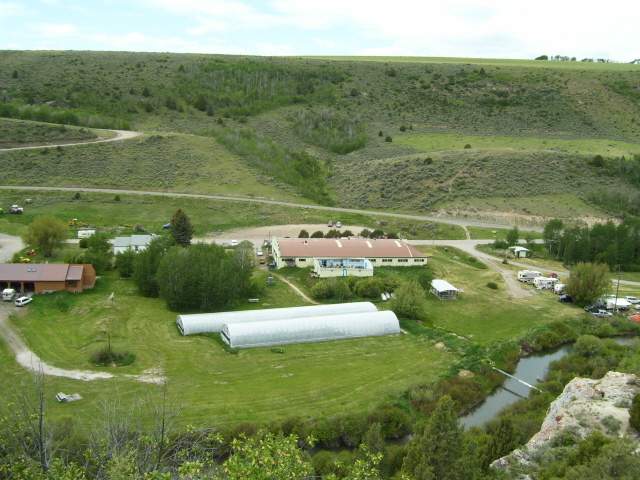
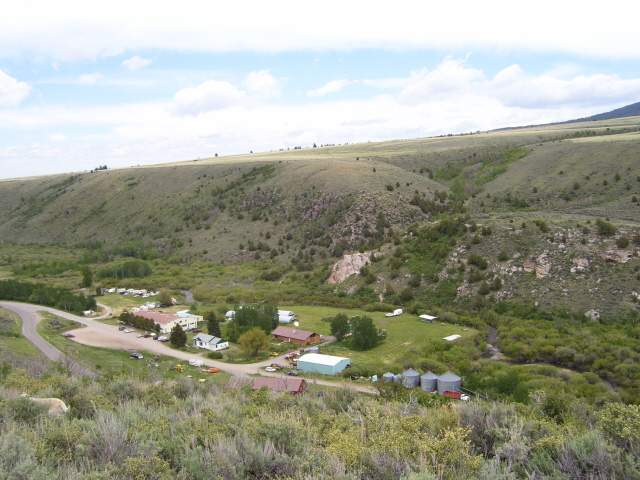
WINTER SWIMMING
Certain things just naturally belong together; milk and cookies, hamburgers and French fries, lemonade and summer. It would seem natural that hot spring soaking and winter would be one of those natural compliments. Before we could open I the winter for more than an hour o two at a time, the problem of cold air and hot water creating steam had to be over come. I explained in chapter 7 about the problem of steam in the cold weather.
On a chilly winter morning I was in the pool, I had pulled back a corner of the tarp and had climbed in under the plastic and was enjoying a soak when I noticed that the pool walls (above the water line) were dry. The underneath side of the plastic tarp, with cold air above it, was dripping water. But the walls were dry- both in the very same, very moist air. It was then that I realized that the problem wasn’t the moist air, but rather the moist air condensing on cold objects, such as the ceiling over the lobby. Winter swimming could become a reality! If we could keep things warm enough.
After trying several forms of heat, the method that we liked the best was to place two 350,000 BTU propane space heaters down in the basement. The air circulates from the open basement door, gets heated by the heaters, travels through the lobby, kitchen, and pool, and then is exhausted through the fans in the roof and hot pool. It is very expensive to run the space heaters, but it made winter swimming possible.
We only open during the most popular hours of the week (6-9 P.M. on Fridays and noon-9 P.M. on Saturdays) because of the heating expense. The rest of the week the pool is covered with the plastic tarp and heated by the hot water (chapter 7) in the pool.
In 1981 we made the big step into winter swimming, and it has gotten more and more popular.
In the pre- 1981 era we had to make our living for six months a year and make it stretch the other six months. We are by no means rich, but the extra income from winter swimming has made business much less of a scary ordeal.
THE HOT POOL
Like bread and jam, if you have a swimming pool, you need a hot soaking pool.
Over the years I noticed that the most popular spot in the pool, among adults, was the hot water pipe in the middle of the steps on the south end of the pool. One day my Uncle Darwin said, “My word, you need to try the hot pool at Banberry Hot Springs. It is so nice; you would come right home and build one!”
So in 1984 we borrowed $35,000 from key Bank and started our new pool. We did much of the work ourselves. Others that helped were Reed Summers, who did the cinder block work, Keith Cutler and Ted Dye did the floor and pool concrete work, and Ard’s Glass and paint put in the big glass door.
Spring opens a fresh new year, and so did we in 1985 with our hot pool, complete with Jacuzzi jets and a cold dunking pool in the corner. We were ready for business!
Few of life’s experiments or ventures turn out like we really plan or hope, but this one was even better. We charged an extra $0.25 for people to use the hot pool.
Everybody loved it! We saw a steady increase in the number of bathers, as well as an increase in our income. Within three years the loan was all paid back (two years ahead of schedule!) The new pool was free and clear. Our biggest fan- is me! I have my ceremonial soak every night and every morning. As I get older, I love it even more. I can be happy with a modest living, so long as I get my twice daily soaks!
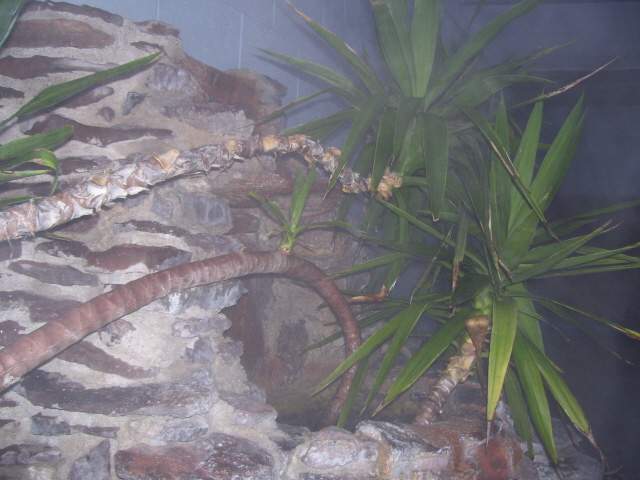
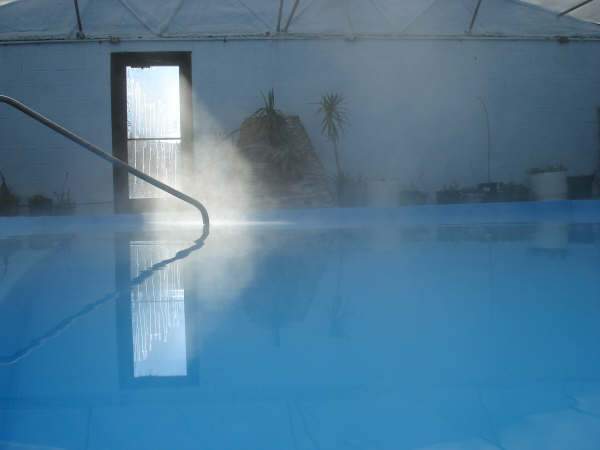
THE SWIMMING LESSONS
From time to time when I was a boy, the local Red Cross organized a swimming lesson program and brought kids out in a school bus for their lessons. They brought their own instructors and we just provided the water. But by 1964, quite a few years had gone by with no swimming lessons and many people inquired of my parents if they would do a program. My Dad and two older sisters, Bernice and Bert enrolled in a night class at Ricks College and certified as Red Cross water safety instructors. The following summer they started to teach.
The first year, we had a car pool of kids from Teton, Idaho as our only students. The next year Tetonia signed up, the next year another community, and so on. Before long all the little communities from Sugar City to Victor had their car pool group and came for their lessons.
At first we just let each group pick 10 lesson days and mark them on a calendar. As you can guess, before long we saw the need to organize. So we organized them as either M-W-F classes or T-Th-S classes. We would teach an 8, 9, and 10 o’clock group each day. In the fall of +- 1982 we had a group of parents from the West Jefferson County area request us to do a late summer group just for them. Due to the distance of travel, they asked if they could camp here and do two lessons each day and be done in five days.
So we put it together and it turned out to be a lot of fun. The kids did well with their lessons and the camping/swimming experience seemed to be a big hit.
The next year we did it again, and added a second group like the West Jefferson group. Within a few years, everyone wanted the swim and camp groups instead of the M-W-F or T-Th-S groups. By the third or fourth year we were doing swim camps exclusively.
We have always tried to give a good quality lesson. Most of our instructors are family members or kids who lifeguard for us and all are Red Cross certified water safety instructors.
Combine quality with the one week camping and swimming experience, and it is little wonder that our lessons are just getting more and more popular each year. The year 1003 was completely booked by Feb. of 2003. 2004 was completely booked by September of 2003. We love the kids and they seem to love to come here. Many come from Idaho Falls, Blackfoot, Montana, Utah, Wyoming, Nevada, as well as many locals.
Once again- something that worked even better than we had hoped for.


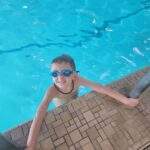
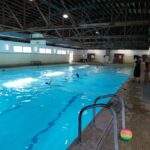
THE FUTURE OF GREEN CANYON HOT SPRINGS
It has been a great 100 years. What of the future?
Of course we all know that the future belongs to a higher power and is to a large extent out of our control. So this final chapter in our history I will just comment on and not predict.
There are two problems that the future holds for Green Canyon. One is that our building is now aging and cannot be expected to last forever. The piping under the concrete floors are getting ad and the roof needs replacing again (we are already on our second roof). There will certainly come a time when, as my Dad used to say, “We are putting good money- after bad.” It will be costly to rebuild, but it’ll be costly to maintain.
The second problem is that the real-estate value of the property is worth more than its business value. There are very few privately owned hot springs in the world. Every year we have Realtors call on us to see if we would be willing to sell to a “rich client who would pay pretty much whatever we wanted”. Even one million dollars put in the bank on small interest would provide many times the income that we make each year. There would be no work and no risk. But I have never met a rich person who would like to run a swimming business. The purchase offers are from people who would close it up to the public and entertain their family and friends at “our ranch in Idaho.”
Will it be sold at top dollar? Will we build a gold course? Will we build a lodge? Can we ever afford to rebuild the pool? Will any of my children have an interest in the business?
These are questions that I ask everyday, and yet have no answers for. One thing is certain however- at 50 years old, they will be primarily answered by the next generation.
THANK YOU ALL FOR THE GREAT 100 YEARS!
-PHIL GENE NEIBAUR,
Joint Owner and manager of Green Canyon Hot Springs
FIVE MORE STORIES
There are five short stories that I forgot to put in the main history.
Story 1
Neither my dad or grandfather ever saw a rattlesnake on Canyon Creek. Neither have I, and I have never known why. Just a few months ago I was told this story by El Ray Klingler and it makes perfect sense to me.
In the old days, El Ray’s dad or granddad used to herd sheep in this area and was always plagued by rattlesnakes. He knew that the blow snakes and the rattlesnakes were natural enemies and that the blow snakes were the dominant species. One day Mr. Klingler found a nest of small blow snakes (I think out in the Jefferson County desert), put them in a gunny sack, brought them to our canyon and turned them loose. They must have thrived because now there are many harmless blow snakes in the area. For three generations now, we have never seen a rattlesnake.
Story 2
The old pool was built with only a small drain so it took many hours to drain the pool. When Bob Thueson took over the business, one of his projects was to replace the old drain with a new 16-inch drain with a big gate valve. Not too long after the installation of the new drain, a young man by the name of Gene Palmer could not be found by his buddies during the time the pool was draining. As you can probably guess, he had been sucked through the new drain and found in the ditch that took the drain water from the pool. He was scratched and bruised a little, but thankfully alright.
(Don’t try it in our pool kids—we now have a butterfly valve. “Ouch!”)
Story 3
The tile work for the new pool was contracted by a company called “Kelly Tile.” The tile crew would stay at the pool for days to work and they would campout in the dressing rooms. One night, some of the men got into an argument. One worker was so mad at the others that he had to vent his anger somewhere. Instead of starting a fight, as so many of us would, he got up from his bed and began to lay tile. When his fellow crew members got up the next morning, they were surprised to find a major part of the job done. (I have tried that with my wife—it doesn’t work.)
Story 4
In the old pool, the dressing rooms lined the sides of the pool and were only about four feet from the water. One day, Myrtle Neeley was changing to get into the pool. She bent over to pull her swimming suit up and almost grabbed a coiled snake that was under the bench in her dressing room. It scared her so bad that she jumped backwards into the dressing room door. The door flew open and she tumbled backward into the pool with her swimming suit still around her ankles. (Don’t try this at home boys and girls!)
Story 5
One day, as we were teaching swimming lessons, a big blow snake came shooting out of the hot water pipe into the pool. It must have crawled into the hot springs and got sucked down the pipe that comes down to the pool. The snake came out unharmed and joined our swimming lessons. He swam down to the rope in a zigzag fashion and coiled itself around the rope. My sister-in-law, Jeralee, came to the rescue of the snake—and kids. Everyone else was afraid of the snake, me included. Needless to say, we have never been accused of having “hum-drum” swimming lessons.

